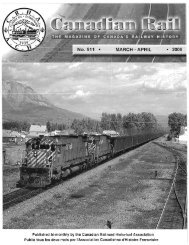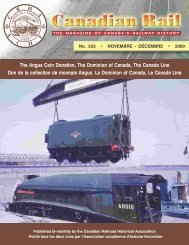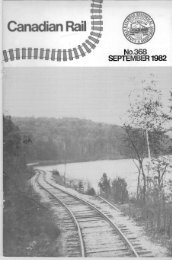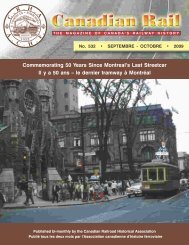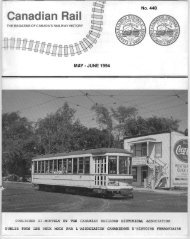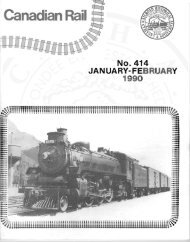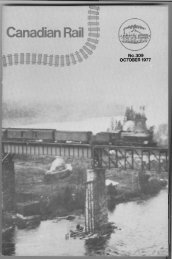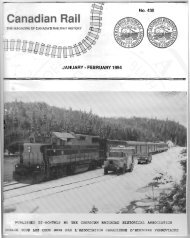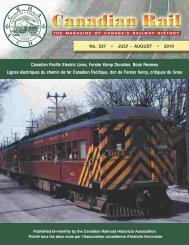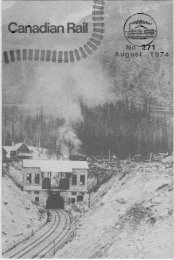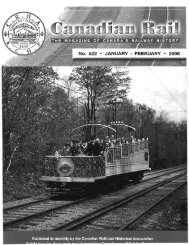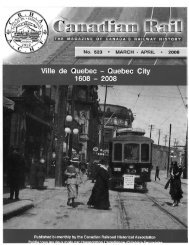Canadian Rail_no525_2008 - Le musée ferroviaire canadien
Canadian Rail_no525_2008 - Le musée ferroviaire canadien
Canadian Rail_no525_2008 - Le musée ferroviaire canadien
You also want an ePaper? Increase the reach of your titles
YUMPU automatically turns print PDFs into web optimized ePapers that Google loves.
JULY - AUGUST <strong>2008</strong><br />
141 CANADIAN RAIL • 525<br />
Montreal-Sherbrooke trains. The St. Constant station<br />
was the proverbial; "hop, skip and a jump" by foot to the<br />
proposed Museum entrance offofrueSaint-Pierre.<br />
Endorsement of the <strong>Canadian</strong> <strong>Rail</strong><br />
Transportation Museum and a promise of tangible cooperation<br />
were sought and received from the Presidents<br />
of <strong>Canadian</strong> National and <strong>Canadian</strong> Pacific <strong>Rail</strong>ways.<br />
Both the <strong>Canadian</strong> and Quebec Governments granted<br />
charitable status to the Association thereby making<br />
donations to the museum project - whether of money,<br />
construction materials, or exhibits - a deduction from<br />
taxable income.<br />
1961 - CONSTRUCTION BEGINS<br />
As the first sod was turned on July 15,1961, many<br />
members reckon this date to be the museum's birthday.<br />
Construction commenced, and just in time, as by then the<br />
museum had accepted the donation of 35 locomotives<br />
and cars.<br />
A financial campaign, headed up by Dr. Nicholls<br />
to raise $ 210,000 for a building, yard trackage, fencing<br />
and other essentials, had been launched in 1960. Dr<br />
Nicholls, who was not used to fundraising, commenced<br />
making appointments with the presidents of various<br />
potential donor companies. The campaign was<br />
sufficiently successful to permit the Directors to<br />
authorize the expenditure of up to $ 10,000 for the<br />
construction of the museum's first building. This was<br />
planned to be a modest affair, 80 X 165 feet, built of wood<br />
poles and aluminum sheathing. Because of the level of<br />
donation, it was decided to build a more durable structure<br />
with proper cement footings and steel girders. As<br />
donations continued to come in, it was decided in 1962 to<br />
double the length of Building One (today Building 5) to<br />
330 feet.<br />
Supplies began arriving in Spring 1962.<br />
With the exception of the doors and back wall, the<br />
structure was entirely sheathed in aluminum siding<br />
by July 10th. The back wall was completed by May<br />
1963, by which time temporary doors had been<br />
constructed by volunteers. Permanent roll up doors<br />
were put in place by<br />
November 2,1963 - just in<br />
time to keep out the<br />
winter's snow that would<br />
start falling later that<br />
month. Our member the<br />
late Frank <strong>Le</strong>win, who<br />
was a residential<br />
developer in the St.<br />
Sauveur area, was a great<br />
help in the early<br />
construction phase of<br />
Building One at the<br />
museum.<br />
The first solicitation<br />
pamphlet requesting<br />
support for the new<br />
<strong>Canadian</strong> <strong>Rail</strong><br />
Tr an s po r tat ion<br />
Museum.<br />
La premiere brochure<br />
sollicitant d es<br />
contributions pour la<br />
realisation du nouveau<br />
musee du transport<br />
fenoviaire. (Archives<br />
del'ACHF)<br />
Montreal-Sherbrooke. La gare de Saint-Constant etait Ie<br />
lieu du proverbial « En avant, saute! » d'ou l'on se<br />
dirigeait vers l'entree du Musee a partir de la rue Saint<br />
Pierre.<br />
<strong>Le</strong>s presidents du Canadien National et du<br />
Canadien Pacifique promirent leur appui et leur<br />
cooperation au Musee <strong>canadien</strong> du transport sur rail. <strong>Le</strong>s<br />
gouvernements du Canada et du Quebec accorderent Ie<br />
statut d'organisme de bienfaisance a l'Association,<br />
permettant ainsi que les dons pour Ie projet de musee,<br />
sous forme d'argent ou de materiel, puissent etre<br />
deductibles d'impot.<br />
1961- DEBUT DES TRAVAUX<br />
Plusieurs membres considerent Ie jour de la<br />
premiere levee de terre, Ie 15 juillet 1961, comme la date<br />
anniversaire du Musee. II n'etait pas trop tot pour<br />
commencer les travaux puisqu'on avait deja accepte les<br />
dons de 35 vehicules <strong>ferroviaire</strong>s.<br />
<strong>Le</strong> regrette Dr Nicholls prit la tete d'une<br />
campagne de levee de fonds en 1960 afin d'amasser les<br />
210 000 $ necessaires a la construction du bfttiment et de<br />
I'installation de voies de garage, de clotures et autres<br />
elements essentiels. M. Nicholls, qui n'etait pas familier<br />
avec les campagnes de souscription, prit rendez-vous<br />
d'abord avec les presidents de differentes compagnies<br />
susceptibles de faire des dons. La campagne eut<br />
suffisamment de succes pour permettre aux<br />
administrateurs d'autoriser un montant de 10 000 $ ailoue<br />
a la construction d'un premier batiment pour Ie Musee.<br />
On songea d'abord a un modeste abri de 80 X 165 pieds<br />
(24 X 50 metres) constitue de poteaux de bois et recouvert<br />
de tales d'aluminium. Mais etant donne Ie montant eleve<br />
des dons, on decida plutot de construire une structure<br />
YOUR<br />
IS<br />
I~<br />
plus durable avec fondation de beton et<br />
poutrelles d'acier. Comme les dons se<br />
poursuivirent, on decida en 1962<br />
d'allonger ce hangar numero 1 (actuel<br />
hangar numero 5) de plus de 100 metres.<br />
<strong>Le</strong>s materiaux arriverent au<br />
printemps 1962. <strong>Le</strong> 10 juiilet, la structure<br />
etait deja entierement recouverte de tales<br />
d'aluminium, a I'exception des portes et<br />
du mur arriere. Ce dernier fut complete<br />
en mai 1963 tandis que des portes<br />
temporaires furent installees par des<br />
benevoles. On posa enfin les portes<br />
coulissantes permanentes Ie 2 novembre<br />
1963, juste avant les premieres chutes de<br />
neige. <strong>Le</strong> regrette membre Frank <strong>Le</strong>win,<br />
qui etait a la tete d'une entreprise de<br />
construction domiciliaire dans la region<br />
de Saint-Sauveur, fut d'un grand secours<br />
pour la premiere etape de l'erection du<br />
hangar numero 1.



